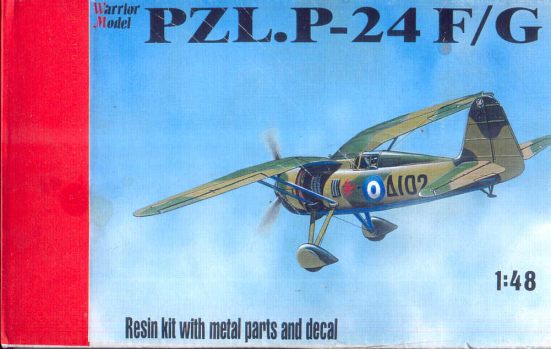
Warrior Models 1/48 PZL P.24F/G
|
KIT # |
48006 |
|
PRICE: |
$64.95 |
|
DECALS: |
Five aircraft |
|
REVIEWER: |
|
|
NOTES: |
Resin with metal parts |

|
HISTORY |
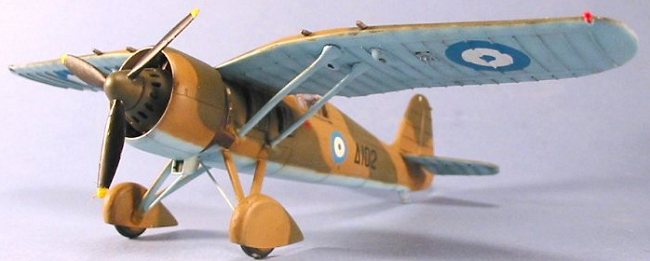
For a developmental history of the P.24G, go check out the preview.
The Greek Finale of the P.24G:
On October 28, 1940, Italy attacked Greece. The 21, 22 and 23 Mire Dioxeos (Fighter Squadrons) of the Elleniki Vassiliki Aeroporia (Hellenic Air Force)were equipped with a total of 25 serviceable P.24F and P.24G aircraft, and were charged with the defense of Salonika, Kastoria, Kozani and Larisa. On November 1, a P.24 of 21 Mira opened the score for the Greeks, shooting down an unidentified Italian aircraft north of Ioannina. On November 2, P.24s of 22 Mira intercepted 27 Cant Z.1007 bombers, escorted by Fiat C.R.42s, approaching Salonika. The first attack took down three of the Cants, while the rest jettisoned their bombs and turned back in defeat. Lt. Mitralexis, who shot down one of the Z.1007s, severed the tail of a second with his propeller, then made a successful crash landing.
 On November 14, all
three squadrons claimed a total of 10 Italian aircraft, with Lt. Laskaris
claiming an S.79 Sparviero and a C.R.42. On November 18, the three
squadrons initiated an offensive patrol over Macedonia, during which they
claimed five bombers and two fighters, for a loss of three P.24s.
On November 14, all
three squadrons claimed a total of 10 Italian aircraft, with Lt. Laskaris
claiming an S.79 Sparviero and a C.R.42. On November 18, the three
squadrons initiated an offensive patrol over Macedonia, during which they
claimed five bombers and two fighters, for a loss of three P.24s.
The Greek fighters constantly operated under adverse conditions, outnumbered by the enemy, with no spares, and poorly-equipped secondary airfields for bases. On December 20, 22 Mira's P.24s at Ptolemais airfield were bogged down in mud so deep there was no hope of the fighters flying away. Over 4 days, the P.24s were disassembled, moved by road to Sedes, reassembled and flown away. The following week, the P.24s of 21 Mira were grounded due to heavy snowfall on their airfield. Two hundred villagers, including women and children, worked for a day and a half to clear the snow so the squadron could rejoin the fight.
Severe winter conditions and spares shortages resulted in a dwindling number of P.24s taking to the air to oppose the marauding Italians. When 21 Mira was re-equipped with Gladiators in January 1941, the squadron's surviving P.24s were distributed to 22 and 23 Mire. On February 9, eight P.24s from 22 and 23 Mire, accompanied by four Gladiators of 21 Mira, intercepted 12 S.79s escorted by 10 C.R.42s and M.C.200s over Klessoura, shooting down seven fighters and two bombers for a loss of only one P.24 and one Gladiator.
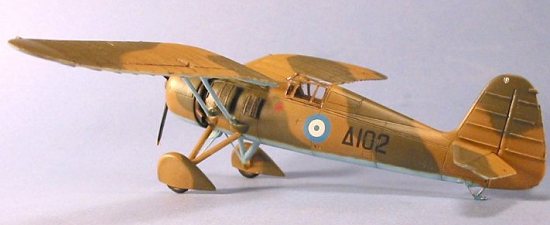 P.24 availability had
reached a low ebb when the Luftwaffe attacked in April, 1941, with a
series of devastating attacks on Greek airfields that left only seven P.24s of
both 22 and 23 Mire still operational. By April 24, when the last
surviving P.24 took off for Cairo, the little fighters had managed to shoot down
three German aircraft against overwhelming odds. The P.24s had been responsible
for the majority of the 68 Italian and German aircraft destroyed in the six
month conflict; their 2.5:1 kill ratio was more than respectable when compared
with the achievements of other, better-equipped air forces.
P.24 availability had
reached a low ebb when the Luftwaffe attacked in April, 1941, with a
series of devastating attacks on Greek airfields that left only seven P.24s of
both 22 and 23 Mire still operational. By April 24, when the last
surviving P.24 took off for Cairo, the little fighters had managed to shoot down
three German aircraft against overwhelming odds. The P.24s had been responsible
for the majority of the 68 Italian and German aircraft destroyed in the six
month conflict; their 2.5:1 kill ratio was more than respectable when compared
with the achievements of other, better-equipped air forces.
While in the near term the P.24s had lost their fight to defend Greece, their resistance had an effect beyond all imagining: Hitler had planned to attack the Soviet Union in May, as soon as the roads solidified from the Spring mud. When the world's worst paperhanger went to the aid of his even more incompetent ally in the Balkans, his schedule was thrown off. The true victory of the three squadrons of obsolete Greek fighters would come when the heretofore-mighty Wehrmacht froze to death in Russia six months later.
|
THE KIT |
In case you didn't
know it, I am a fan of Warrior Models kits. They are truly "garage kits," being
solely the product of the skill of Tadeusz Bialowski. You may not know it, but
there is a 1,000-year history of quality wood-carving in Eastern Europe, which
can be seen in myriad works of art through the ages (and not just wood, but
those made from molds that were carved), and in the surface detail of Eastern
European kits. Tadeusz' kits are premiere examples of this talent. And this
kit, 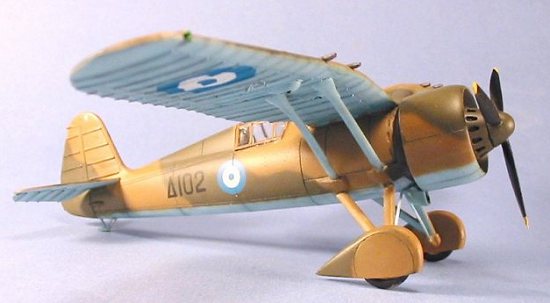 which reproduces the
extremely-difficult-to-reproduce "Wibault corrugation" in its perfectly-done
"Polish wings," is the best kit yet produced by Warrior Models.
which reproduces the
extremely-difficult-to-reproduce "Wibault corrugation" in its perfectly-done
"Polish wings," is the best kit yet produced by Warrior Models.
In total number of parts, the kit is simple. In quality of each part - be it the resin airframe or the white metal cockpit details - this kit is as close to a work of art as model kits get. The production design makes this perhaps the easiest "garage kit" to turn into a contest winner I have yet found.
Decals include markings for all-silver Turkish and Greek P.24Fs, and three camouflaged Greek Air Force P.24Gs, including one flown by Lt. Laskaris of 21 Mira, who was perhaps the leading Greek pilot in the struggle. Given the combat history of the Greek P.24s, I had no trouble to do the one flown by Lt. Laskaris.
|
CONSTRUCTION |
In this case, I started with the 5-part wing. I sanded down each part, to insure a smooth leading edge and a thin trailing edge, and assembled them. With some test-fitting and sanding of parts, the fit was so good and so close that no putty or Mr. Surfacer was needed. The quality of the surface detail on the wing has to be seen to be believed.
I then sanded the fuselage along the centerline joint to get that smoothed out, and to insure thin trailing edges to the rudder. I also took the time to sand down the engine to fit inside the cowling. Past that, everything fit perfectly. I painted the cockpit parts light grey, detailed the instrument panel, made some seat belts from lead foil, and everything was done.
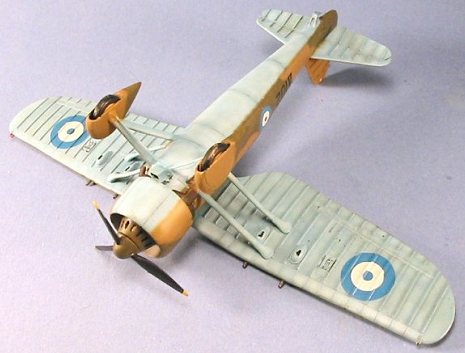 The leading edge of
the wing stuck out a bit from the fuselage. I had no photos to support this
configuration, so I cut back the area of fit for the wings to the fuselage by
1/32 inch to make that joint smooth, and all looked well when attached. With
just enough C-A glue, the gap was filled in the fuselage-wing joint when I
attached the wing, and no putty or Mr. Surfacer was needed. I only needed Mr.
Surfacer along the centerline of the fuselage. The horizontal stabilizers fitted
with no problem - be aware that the side with the prominent ribs is the lower
side.
The leading edge of
the wing stuck out a bit from the fuselage. I had no photos to support this
configuration, so I cut back the area of fit for the wings to the fuselage by
1/32 inch to make that joint smooth, and all looked well when attached. With
just enough C-A glue, the gap was filled in the fuselage-wing joint when I
attached the wing, and no putty or Mr. Surfacer was needed. I only needed Mr.
Surfacer along the centerline of the fuselage. The horizontal stabilizers fitted
with no problem - be aware that the side with the prominent ribs is the lower
side.
The white metal bracing struts of the wing and landing gear fit perfectly. While the few photos of Greek P.24s showed that once war began and they moved to the secondary fields, the spats were dispensed with, the white metal gear struts associated with the wheel-only layout were not that well-cast; I therefore used the set for spats - this layout looks better even if it is not historically accurate.
I painted the engine in various Model Master Metalizer colors, and painted the exhaust. I decided to leave assembly of the engine to the cowling and the exhaust to the engine and all of that to the rest of the airframe until the rest of the model was painted.
|
PAINT & DECALS |
Painting:
After pre-shading the
model with airbrushed flat black, I painted the lower surfaces with Tamiya "Sky
Blue", which was  lightened
with White for highlighting and post-shading. I used Gunze-Sanyo "Tan" and
"British Dark Green" for the upper camouflage colors, each lightened a bit after
original application for post-shading. The entire scheme was done freehand,
since the one available photo of a camouflaged Greek airplane led me to believe
these had "field applied camouflage" since they were originally delivered in
aluminum lacquer. When finished, I gave the model a good coat of Future.
lightened
with White for highlighting and post-shading. I used Gunze-Sanyo "Tan" and
"British Dark Green" for the upper camouflage colors, each lightened a bit after
original application for post-shading. The entire scheme was done freehand,
since the one available photo of a camouflaged Greek airplane led me to believe
these had "field applied camouflage" since they were originally delivered in
aluminum lacquer. When finished, I gave the model a good coat of Future.
Decals:
The decals in the kit are excellent, being thin enough that the wing insignia settled right into the very tight and delicate "wibault" corrugations under a single application of Micro-Sol.
|
FINAL BITS |
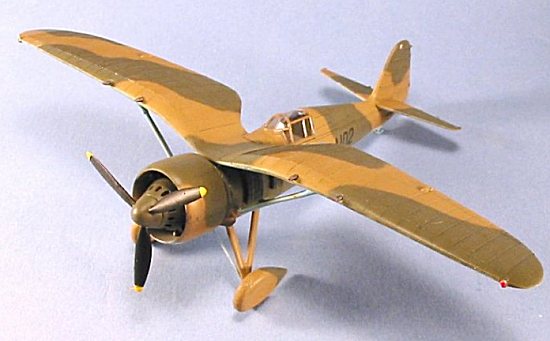 I assembled and
attached the engine, cowling, spinner fairing and prop, then gave the model two
coats of thinned Dullcote. I had planned to assemble the canopy in the open
position, but realized after I had cut it loose from its backing that it was
designed to fit in the closed position. I may yet modify the second canopy so
it can be displayed open.
I assembled and
attached the engine, cowling, spinner fairing and prop, then gave the model two
coats of thinned Dullcote. I had planned to assemble the canopy in the open
position, but realized after I had cut it loose from its backing that it was
designed to fit in the closed position. I may yet modify the second canopy so
it can be displayed open.
|
CONCLUSIONS |
This is a beautiful example of what a good all-resin model kit should be like. I look forward to displaying the Pulawski's Gulls next to the Mirage P.11c as soon as I get the other kit. The kit is expensive, but you get good value for money spent. If the odd and different attract you, this is one to consider.
|
REFERENCES |
I know that Tom doesn't do references, but one of the best on the war in Greece is Air War for Yugoslavia, Greece and Crete by Shores, Cull and Malizia, Squadron Press, 1987. Ed.
December 2002
Copyright ModelingMadness.com
Review Kit courtesy Warrior Models.
If you would like your product reviewed fairly and fairly quickly, please contact the editor or see other details in the Note to Contributors.